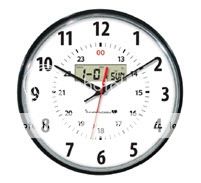Maintenance Free Clock Systems for each Application
 Maintenance free clock systems are an appealing perfect for any sort of business owner on a restricted budget plan with a great deal of timepieces that have to be synchronized. The good news is, clock systems running maintenance free can be discovered everyday, all over the world. Certainly, nowadays such a system is conveniently adaptable to any kind of imaginable application as well as for a wide range of industries.
Maintenance free clock systems are an appealing perfect for any sort of business owner on a restricted budget plan with a great deal of timepieces that have to be synchronized. The good news is, clock systems running maintenance free can be discovered everyday, all over the world. Certainly, nowadays such a system is conveniently adaptable to any kind of imaginable application as well as for a wide range of industries.
Clock systems free of upkeep don't imply that you can forget about them entirely and also anticipate them to run forever. You may need to transform the batteries each year (or possibly as infrequently as once every five years), or reset the time twice a year for daylight savings time and after power outages.
You might have to operate portions of the system and/or offer input to them. For example, the organizing of occasions may need to be adjusted occasionally, and scrolling message boards may need to be supplied updated material.
But all these tasks are fairly trivial. And also that's about the extent of the upkeep tasks involved.
Nevertheless, the actual benefits to a business are a lot more profound than simplifying upkeep. There are obviously economic incentives from reduced maintenance costs. But the boon to productivity is even much more rewarding and often more substantial than initially expected.
What do we indicate by a clock system? This term describes some type of mechanism that keeps all of the clocks belonging to the same enterprise precisely in synchrony.
Any events triggered by specific times (such as the ringing of school bells) are thus managed to occur simultaneously. Any control that has to take place between separate entities (departments) occurs with maximum efficiency because everyone is marching in time to the same drummer.
Clock systems have to be designed in a certain way to achieve optimum precision and to be cost-free of upkeep. The most important design attribute is centralized control of the timekeeping. There have to be one time source at the heart of the system, with all clocks integrating directly to it.
The transmission medium used to integrate the clocks can be hardwired or wireless, and both methods are essentially comparable in regards to reliability. However, developers usually like wireless clock systems since the setup costs are equally much less (virtually imperceptible), upkeep is trivial, as well as system updates or substitutes are conveniently completed.
The other crucial style feature is a regularly quick set/reset mechanism for each timepiece. This is hardly a problem for digital (or at least electronically controlled) clocks in that data are dependably quick and consistent.
On the various other hand, analog user interfaces need relays or similar transformers that take a digital stimulus and produce a mechanical response. Developers of such interfaces must take care to avoid timing inconsistencies or time lags from one clock to the next.
Once this degree of timing precision is in place, supervisors find that they can implement operations research and quality control at a whole new level. They can measure task durations far more properly and use these information to better home in on critical paths and bottlenecks.
Making improvements in this way is conveniently apparent in the manufacturing market since enhancing setting up lines is pretty much the name of the game. No hiccups in manufacturing and no delays, either at the sending end or receiving end, in handing off something from one section to another, indicates productivity goes to its best, employee stress is at its lowest, and niggling distractions are eliminated.
But synchronization leads to improvements in other industries as well. As an example, federal government procedures require much communication and coordination among various divisions as well as entities. Much of the streamlining in manufacturing enabled through synchronized clocks carries over below.
Educational institutions benefit from synchronization since absolutely everything is tied to a routine. If the bells do not supplant synchrony altering lessons for the entire pupil body comes to be disorderly and also disjointed. Accuracy timing allows college supervisors to minimize the duration between periods, thereby taking full advantage of instruction time.
The benefit to hospitals is different from that experienced by the other sectors we have been going over yet it is equally extensive. The major distinction is that the schedule applies to each individual client instead than to the entire group as a whole. The seriously essential details is the relative time between occasions appropriate to correct caregiving.
Synchronized Wireless Clock Systems
Patients move continuously, being confessed, after that delivered from ward to ward as well as among various medical professionals as well as registered nurses. They all rely upon the timing given on the chart to be accurate. The only way this can happen is if all clocks connected to the hospital (including those governing first responders) are exactly in sync.
Again, this aids in even more than one means. Synchronization reduces inadvertent errors, which sometimes can be dire or even fatal. But it also saves hospital administrators from having to focus on low-level problems and frees them up to concentrate on ways to make things even better.
We stated above that although your clock system could be maintenance free, there could be changes one has to make sometimes. Nevertheless, some systems also prevent the demand for this, getting its time resource from an atomic clock or GENERAL PRACTITIONER satellite and updating all wrist watches via its broadcast signal.
These digital systems will certainly even automatically change all the clocks to reflect daylight saving time. This is especially helpful today because it is difficult to keep track of the fall and springtime dates when the changes enter effect.
Another kind of maintenance savings comes from the use of solar clocks. Schools employ them frequently due to the fact that of their need to display the time outdoors. These clocks use solar energy to recharge their batteries, helping them to last 5 years without being changed.
There really is no application that can't gain from maintenance totally free clock systems.
